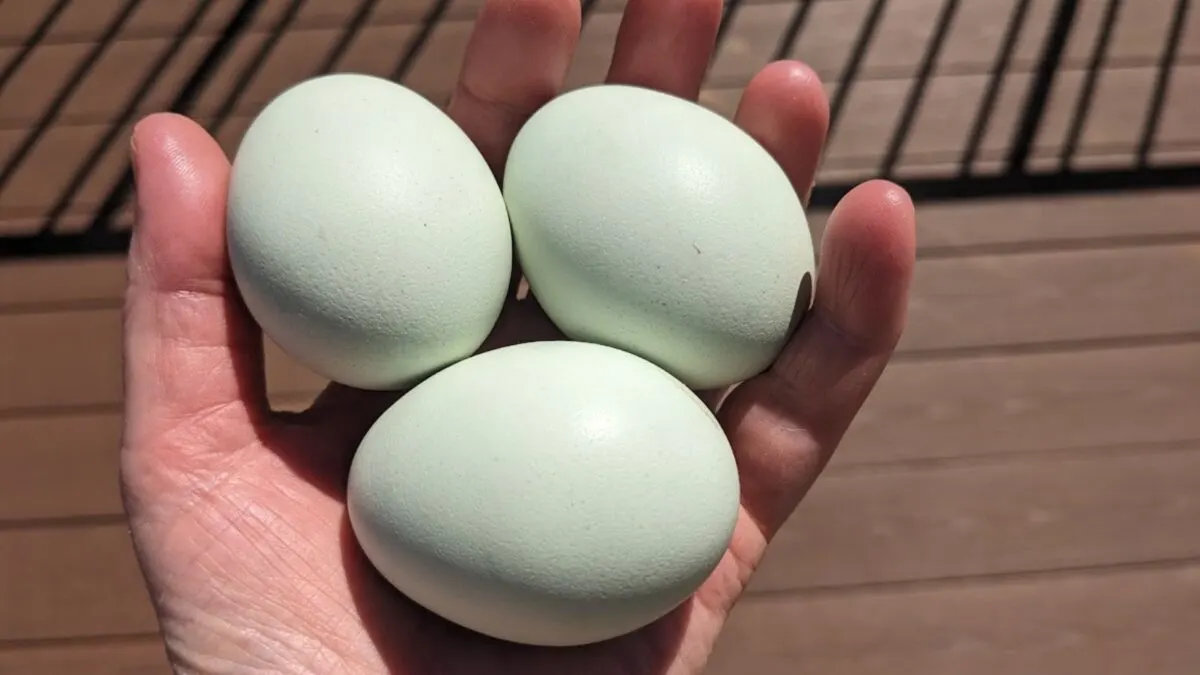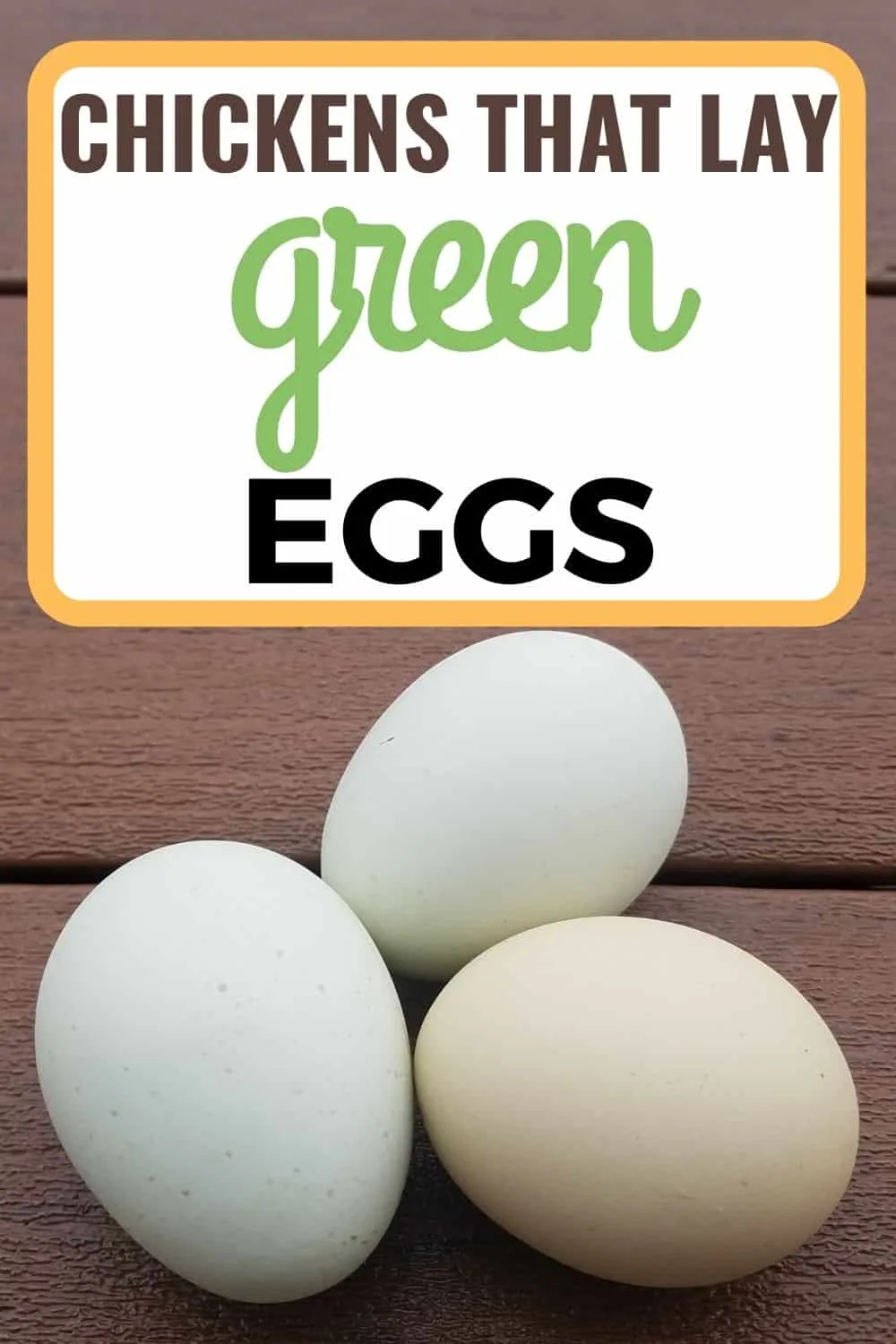As you plan your chicken flock, you, like many others, might want to get chickens that lay different colored eggs. We’re all used to the white and brown eggs you can buy at the grocery store. But did you know there there are some chickens that lay green, blue, gray, pink, olive, and other colored eggs? Let’s look at these chickens that lay green eggs and, who knows, you might just want a few for your homestead.

What Gives The Green Eggs Their Color?
Did you read “Green Eggs and Ham” by Dr. Seuss as a child and wondered if such eggs even existed? They actually exist and are a lot of fun to have in your daily gathering of eggs.
But how do eggs get their shell color?
“All eggs start out with white shells. Those that are laid in shades other than white have pigments deposited on them as the eggs travel through the hen’s oviduct. The journey through the chicken’s oviduct takes approximately 26 hours. The shell takes roughly 20 hours to be complete.” (source)
Chickens That Lay Green Eggs
If you’re a new chicken owner, you might want to get one or two chickens that lay green eggs. It’s fun to get your own, naturally colored Easter eggs built into your flock. If you have children, they’ll squeal with delight when they see pretty colored eggs made by their beloved friends.
Related: Things you should know before getting chickens
1. Isbar, also known as Silverudd Blue
Isbar (pronounced ice bar) chickens come from Sweden. Still fairly new and not common in America yet, Isbar chickens are a bit harder to find and considered a rare breed.
Isbar hens lay between 150 and 200 beautiful green eggs in several shades per year on average. Some even have brown speckles.
This breed of chickens comes in blue, black, and splash colors and weighs between 5-7 pounds. With a pleasant temperament, Isbars are grat for homesteads with children or a growing family that wants to teach the children responsibility by having them care for the chickens.
2. Favaucana, a blend of Faverolles and Ameraucana breeds
A relatively new breed of chicken, Favacuana is a crossbreed between a couple of great chicken breeds: the Favorelle (which makes brown eggs) and the Ameraucana (which makes blue eggs)
Laying between 220-250 gorgeous sage-green-colored eggs per year, the favaucana chicken’s personality is a good combination of the breeds it comes from. They do well in the cold, are amazing foragers, and lay well throughout the year, including winter.
3. Ice Cream Bars, a crossbreed between Isbar and cream Legbar chickens
Just like the Favaucanas the Ice Cream is a fairly new breed of chicken, a cross between the Isbar and the Cream Legbars. The egg color for this breed tends to fall more under the bluish-green color, but it depends on the individual chicken. This egg color comes from the blue eggs of the Cream Legbars and the green from the Isbar.
As this is a fairly new breed it might be more difficult to find at the hatcheries.
A medium-sized bird, the ice cream bar hen will lay between 180-200 blue-green eggs per year.
Something else that is important is the fact that the bird is still a new breed so the temperament is not settled yet. Granted, it is being bred from 2 fairly docile breeds, but that does not always carry over to the new breed. so if you have children, keep an eye out to make sure they are gentle with your kids.
4. Ameraucana (often confused with Easter Eggers)
The Ameraucana is a breed of chicken that comes from Chile and is a very popular breed.
Ameraucanas lay around 200 eggs per year. Production does let up quite a bit in the winter months and can sometimes completely stop.
Ameraucanas are stocky, sturdy chickens, and so they are cold-tolerant. Their legs tend to be gray or green, which is different from the common yellow color that people have become used to seeing.
Ameraucana chickens come in standard and bantam sizes. The standard size weighs roughly 4.5-6.5 pounds per bird, with the males tending to weigh more. The chickens are roughly 18 inches tall.
Temperament-wise, the Ameraucana chicken is very easygoing, tends to be easy to handle, and perfect for families with children.
5. Olive Eggers
As you’ve probably seen a theme going on here, the Olive Eggers is another cross between other chicken breeds. Olive Eggers come from mixing a blue egg layer, such as the Cream Legbar, Ameraucana, or Araucana with a brown egg layer such as Marans or Welsumer.
The result is a chicken that lays gorgeous olive eggs. Sadly, olive eggers aren’t producing a lot of eggs: they lay between 150 and 180 eggs per year. But nonetheless, you need one in your flock if you want a variety of green eggs in your collection.
To learn more about raising chickens, check out Fresh Eggs Daily: Raising Happy, Healthy Chickens…Naturally, by Lisa Steele.
If you end up with too many eggs, you’ll love my list of things to do with eggs.
FAQ about chickens that lay green eggs
Are green egg layers hard to find?
A common question that a lot of new homesteaders or first-time chicken owners have is how hard is it to find chickens that lay green eggs. The answer to this really depends on how particular you are about the breed of chicken you want. For example, Isbars and Ice Cream Bars are a lot harder to find than Easter Eggers. Yet, they all make beautiful green eggs.
Does the rooster determine the egg color?
A common misconception for a lot of new chicken owners is that the rooster determines the egg color. However, that is not the case. The roosters are only meant for fertilizing the eggs and protecting the hens. They do however influence their offspring’s egg color.
Is there a way to predict egg color?
Generally, you’ll know the egg color by the breed you have. But it’s also possible to predict egg color by looking at the chicken’s earlobe color. It might sound funny, but it’s true.
Are green eggs safe to eat?
Yes, green eggs are safe to eat: the only difference is the pigment of the shell, otherwise, the composition is the same as white or brown eggs.
Do green eggs taste different?
No, the green eggs do not taste any different. If your eggs taste different, you need to look at the chicken’s diet, as some foods, such as garlic, onions, and flax seeds, will change the flavor of the egg. For the best-tasting eggs, give your chickens fresh greens.

Adriana Copaceanu is a passionate nature lover living in the country on her dream property where she grows vegetables, lavender, and wildflowers that she shares with the wildlife they attract. When she's not in the garden, she loves spending time with her chickens and planning her next nature project. Check out her books below:
How to Grow Lavender for Fun and Profit: Lessons Learned from Planting Three Hundred Lavender Plants


Top 8 Egg Laying Chicken Breeds
Monday 27th of March 2023
[…] Many small backyard flocks these days contain at least one of these fun, quirky mixes. The Easter Egger is desired for its blue or green egg-laying ability. They lay eggs that look as if they have been dipped in dye (chickens that lay green eggs). […]
11 Breeds Of Chickens That Lay Pink Eggs
Thursday 1st of April 2021
[…] some green egg layers? It’s fun to get a bunch of different colored […]